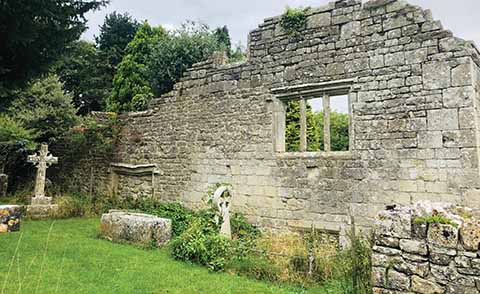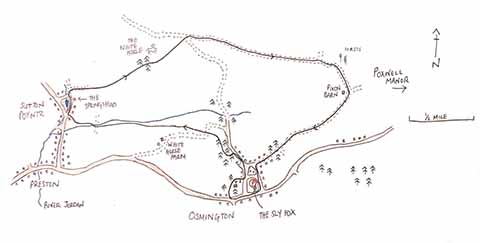Dorset Walk – Osmington & Sutton Poyntz
Catherine Speakman goes walking in the shadow of the White Horse
Published in January ’20
OSMINGTON is a small village often ignored by passers-by en route to Weymouth and by those heading to the better-known Osmington Mills with its popular Smugglers Inn and access to the sea. Osmington is no less deserving of attention, though. Painter John Constable spent his honeymoon here in 1816. He painted vistas of the area: ‘Weymouth Bay’, which is exhibited in the National Gallery, and his lesser-known ‘Osmington Village’.
At the time of writing, the village’s Sly Fox pub was closed ‘permanently’, so as the car park permissions are slightly grey, it is best to park sensitively along the road outside.
Beginning your walk from the Sly Fox, head up the hill leading to the main road. Turn right and stick to the pavement to follow the road up the hill. It is narrow and busy, so take care. Ignore the road to your right and continue straight on, pass the Old School House on your left and, when opposite the turning on the left, arrive at a stile on your right. Climb over and follow the tunnel of trees to the end. Go over a second stile, enter a field and keep your eyes peeled for a metal gate on your right. Turn through the gate to enter the churchyard. As you pass St Osmund’s church on your right, you cannot miss the ruins of the old Tudor manor house on your left. Nothing but walls, windows and a small ancient doorway remains, but it is still a pretty impressive sight. One previous owner was William Warham, whose job it was to crown the young King Henry VIII when Warham was Archbishop of Canterbury.
Pass the large yew trees and exit the graveyard via the old lych-gate: a place where the pallbearers would rest and shelter the coffin following a procession around the village. Or, in slighter older times, where the body would have been laid to rest, dressed just in a shroud, for a few days before the funeral. Turn left down the village road, heading past many thatched cottages and through a small crossroads. On your left pass an old stone wall.
Continue to head down the road and take the slightly hidden footpath on the left that guides you into the woods. Steps help with the steepness. When through the woods, keep the boundary to your right, through the next field and over another stile. It is along this footpath that you get the best view of the famous Osmington White Horse, high up on the hill to your right. Completed in 1808, it was fashioned to honour King George III, who frequented Weymouth for his health. Bathing in the sea was a relatively new concept, mostly confined to poorer people, but King George was sure that it helped him physically and mentally. His visits to Weymouth helped the town immensely as the pastime of swimming in the sea gained increasing popularity throughout the late 18th and into the 19th century.
On approaching Weymouth, King George took offence to the horse representing him travelling away rather than towards the town, so he immediately turned his entourage around and never returned. The artist himself was summoned to London and executed for his error, although alternative stories claim he took his own life. King George himself was growing increasingly unwell during this period and in 1810 he was finally confined to Windsor Palace, an alternative reason for him not revisiting Weymouth. The horse itself needs maintenance, as the chalk regularly becomes overgrown with moss. The last cleaning took place in time for the Olympics in 2012.
Turn right down a track and then left again to follow the footpath over a stile and into a field. Mind out for horses, as this is an area highly populated with them. Head diagonally across, aiming for the next stile in the bottom right-hand corner.
Enter a small yard, turn left over a track and then go straight over another stile. Head straight across the field again, heading for the bottom right-hand corner, next to the River Jordan (aka Osmington Brook). Climb over the stile which is next to a tumbledown stone wall and into the next field. Here views of the rooftops of Sutton Poyntz come into sight. High above them sits Chalbury hillfort and, on another hill, tumuli, both of which provide clear evidence of ancient settlement in the area.
Keep the river on your right and cross over a track to join another footpath. Go through a gate and cross over the river via a small, unnoticeable footbridge. Follow the path round to the left and it brings you to another gate and a bordered footpath, exiting onto the village road of Sutton Poyntz.
In 1902 a huge fire ripped through the village, destroying nearly all the houses on one side of the river. However, restoration took place in the ’sixties, resulting in the picture postcard village it presents today. Sutton Poyntz was featured as ‘Overcombe’ in Thomas Hardy’s The Trumpet Major, which was set in nearby Weymouth during the Napoleonic Wars.
On entering the village, turn right and follow the Preston River upstream on your left. The river opens up to create a duck pond, opposite which sits the Springhead pub. The pub is set in a beautiful location surrounded by willow trees and very chatty, rather expectant ducks, so if you want to make friends, bring some food for them! Stay on the same road, ignoring the turning to your left, then take the footpath on your right down White Horse Lane. Ignore all footpath diversions and continue going straight. After the first field, turn to your left and travel diagonally across it, heading uphill directly towards the White Horse in the distance.
Once over the next stile, enter rough woodland, even with a tree swing to take advantage of! Remain at the bottom of the wood with the fence on your right. When you come to a signpost guiding you up the hill, your climb really starts, the steepness probably making those with even slight vertigo end up with wobbly legs! As you make your way up, you are at your closest to the horse, but viewing it at this angle is impossible. On closer inspection you can make out its chalky legs and you are able to appreciate what a steep canvas it is. Be careful with your footing, though, as the chalky path is slippery whether wet or dry. Take your time with it and enjoy the views expanding behind you.
Once at the top of the hill, join a track where, on turning around, the far-reaching views can be used as an excuse for a sit-down and a rest. To the east you can see as far as White Nothe. Portland stands clearly out in the sea in front of you with Osmington Bay cradled by the island on its eastern side. In stormy weather, this bay provides sanctuary for passing sea traffic so can sometimes be littered with huge cargo-carrying vessels. On sunny days it is often full of small, colourful sailing boats from the nearby National Sailing Academy. Weymouth is also clearly seen with its white Georgian architectural façade and sandy beach. To the west of Portland you can make out Chesil Beach as it disappears off into the distance to the far west.
At the top of the hill turn right and ignore the track on your right taking you downhill. Stay on top of the hill, making your way through a number of gates. On finally reaching the masts, the views open up in front of you and on a clear day the skyline of Poole can be seen. Continue following the track all the way to Pixon Barn. Go through a gate and looking left, down the hill, you can view the village of Poxwell. Poxwell Manor dominates the scene. It is an imposing country house and, like Sutton Poyntz, had a role in The Trumpet Major, playing Oxwell Hall.
At Pixon Barn turn right and go through another gate. Here you have another little climb but once again, at the top, the views are extensive. Osmington Bay opens up in front of you and Portland is beyond. To your right you can view the White Horse and even trace the footpath you have already taken.
Follow the track down the hill. It is easy to stick to and takes you straight down back to the village of Osmington. St Osmund’s church tower peeks out from the valley in front of you, indicating that you are nearly at the end of your walk. Go through another gate and onto a bridleway, tunnelled by trees. Once out of the trees you are faced with the same view that John Constable depicted in his painting, ‘Osmington Village’, albeit slightly modified! When back on the village road, turn left to return to the pub.
Distance: 5 miles/8km
Time: 2 hours
Total climb: 400 ft
Max height: 450 ft
Min height: 85 ft
Terrain: Track, path, road and field.
Exertion: Medium to hard. Some mud after rain and steep climbs.
Start: The Sly Fox (Grid Ref: SY725829, Postcode DT3 6EU).
Map: OL15 Purbeck and South Dorset
How to get there: From Weymouth travel east on the A353. On entering Osmington village, take the second left and the Sly Fox will be on your left.
Dogs: On leads where livestock is present and in accordance with any notices on the walk and The Countryside Code. Few stiles to cross and gates to open. Refreshments frequently offered for them outside private residences both in Osmington and Sutton Poyntz, but don’t rely on this.
Refreshments: The Springhead in Sutton Poyntz





